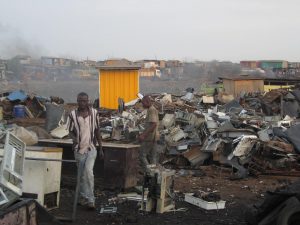3.9. PC Commoditization and E-Waste
The Commoditization of the Personal Computer
Over the past forty years, as the personal computer has gone from technical marvel to part of everyday life, it has also become a commodity. There is very little differentiation between computer models and manufacturers, and the primary factor that controls their sale is their price. Hundreds of manufacturers all over the world now create parts for personal computers which are purchased and assembled. As commodities, there are essentially little or no differences between computers made by these different companies. Profit margins for personal computers are minimal, leading hardware developers to find the lowest-cost manufacturing methods.
There is one brand of computer for which this is not the case – Apple. Because Apple does not make computers that run on the same open standards as other manufacturers, they can design and manufacture a unique product that no one can easily copy. By creating what many consider to be a superior product, Apple can charge more for their computers than other manufacturers. Just as with the iPad and iPhone, Apple has chosen a strategy of differentiation, an attempt to avoid commoditization.
E-Waste

Advances in computing technology reduce costs, increase productivity and allow innovation to flourish. But there is a dark side to advancement. A PC has an expected lifetime of three to five years, and a cell phone is expected to last less than two years. Rapid obsolescence means the creation of ever-growing mountains of discarded tech junk, known as electronic waste or e-waste. In 2016 alone, approximately 44.7 million metric tonnes of e-waste were created. By 2020, it is predicted that the amount will increase by 17% and we will make about 52.2 million metric tonnes of e-waste annually worldwide (Leary, n.d.) Canada is a significant contributor to this e-waste problem. A report released by Statistics Canada stated that, in 2012, we contributed 14.3 million tonnes of waste to the global e-waste problem (Statistics Canada, 2016). Consumer electronics and computing equipment can be a toxic cocktail, including cadmium, mercury, lead, and other hazardous materials. Once called the “effluent of the affluent,” e-waste will only increase with living standards worldwide.
The quick answer would be to recycle, as e-waste contains materials like plastics and aluminum, as well as small bits of increasingly valuable metals such as silver, platinum, and copper. However, there’s often a disconnect between consumers and managers who want to do good and those efforts that are actually doing good. The complexities of the modern value chain, the vagaries of international law, and the nefarious actions of those willing to put profits above principle show how difficult addressing this problem will be.
The process of separating the densely packed materials inside tech products so that the value in e-waste can be effectively harvested is hugely labour-intensive, more akin to reverse manufacturing than any sort of curbside recycling efforts. Therefore, much e-waste is sent abroad, which can be much cheaper than processing it at home. Much of this waste is in China, South Asia, or sub-Saharan Africa.
The modern manager must think deeply about the ethical consequences of a firm’s business. A slip-up (intentional or not) can, in seconds, be captured by someone with a cell phone, uploaded to YouTube, or offered in a blog posting for the world to see. The worst cases expose firms to legal action and can tarnish a brand for years. Big firms are big targets, and environmentalists have been quick to push the best-known tech firms and retailers to take back their products for responsible recycling and to eliminate the worst toxins from their offerings.
“Chapter 2: Hardware” from Information Systems for Business and Beyond (2019)by David Bourgeois is licensed under a Creative Commons Attribution-NonCommercial 4.0 International License, except where otherwise noted.
The Story of Canada’s Digital Dumping Ground by by Alyssa Hunt, Makenna Bailey, Mark Buglioni, and Megan Berr at UBC Open Case Studies is licensed under a Creative Commons Attribution 4.0 International License

